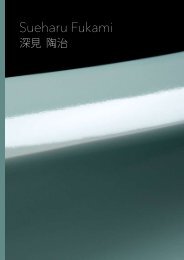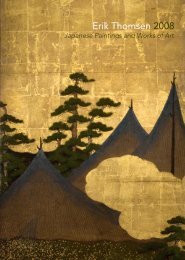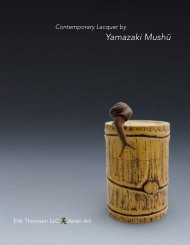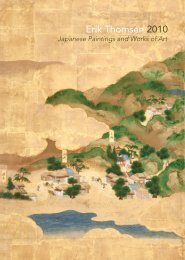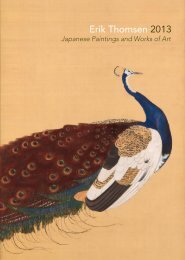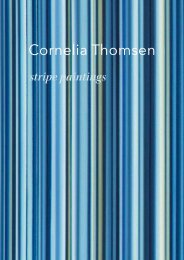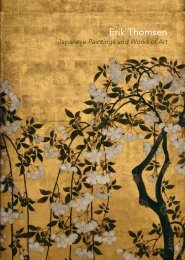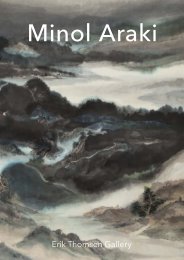Minol Araki (1928-2010) Minol Araki had his first ... - Erik Thomsen
Minol Araki (1928-2010) Minol Araki had his first ... - Erik Thomsen
Minol Araki (1928-2010) Minol Araki had his first ... - Erik Thomsen
You also want an ePaper? Increase the reach of your titles
YUMPU automatically turns print PDFs into web optimized ePapers that Google loves.
<strong>Minol</strong> <strong>Araki</strong> (<strong>1928</strong>-<strong>2010</strong>)<br />
<strong>Minol</strong> <strong>Araki</strong> <strong>had</strong> <strong>his</strong> <strong>first</strong> exhibition at an art gallery in 2005, just five years<br />
before he died. The event came about through the gentle, persistent<br />
persuasion of two close friends.<br />
Perversely, in an era when the word “art” is often accompanied by the word<br />
“market,” <strong>Araki</strong> <strong>had</strong> by then been the subject of numerous one-man museum<br />
exhibitions, at the National Museum of History, Taipei (1978, 1980 and<br />
1999); Hong Kong City Hall Museum--now called Hong Kong Museum of Art<br />
(1977, 1981); Hong Kong City Arts Centre (1999); and the Phoenix Art<br />
Museum (1999), in an exhibition that traveled to further museums across the<br />
United States: the Indianapolis Art Museum, the Morikami Museum, and the<br />
Clark Center for Japanese Art and Culture. And <strong>his</strong> works were in the<br />
collections of a number of distinguished museums, including the Hong Kong<br />
Museum of Art, the National Museum of History, Taipei, the St. Louis Art<br />
Museum, the Indianapolis Museum of Art, the Yale University Art Museum<br />
and the Clark Center for Japanese Art and Culture, Hanford, CA.<br />
<strong>Araki</strong> was not entirely opposed to exhibiting <strong>his</strong> work. He was simply<br />
indifferent to selling it. T<strong>his</strong> indifference is part of the literati tradition in<br />
China and Japan, where learning to master a paint brush was considered to<br />
be part of a refined and fruitful life and art was shared among close friends.<br />
Born to Japanese parents in Manchuria, who were part of an expatriate<br />
Japanese community, <strong>Araki</strong> studied painting from the age of seven in the<br />
brush and ink tradition. After <strong>his</strong> family moved back to Japan following World<br />
War II, he studied architecture and design as a practical matter. Inspired by<br />
the product designer Raymond Loewy and <strong>his</strong> book Never Leave Well Enough<br />
Alone (1951), <strong>Araki</strong> decided to become an industrial designer and opened a<br />
studio, NOL Industrial Design. His <strong>first</strong> major client was Tandy<br />
Corporation/Radio Shack, for which he designed the rest of <strong>his</strong> life. In the<br />
60s he started a separate design firm for household accessories, PIPa, and<br />
<strong>had</strong> considerable success as an independent designer and producer, selling at<br />
stores such as Bloomingdale’s, Dunhill, Georg Jensen and Design Research.<br />
Throughout <strong>his</strong> life, <strong>Araki</strong> continued to paint. His efforts intensified after<br />
1973, when he met the noted Chinese master painter Chang Dai-chien, with<br />
whom he developed a lasting friendship. By then, <strong>Araki</strong> was traveling<br />
frequently to Hong Kong, Taiwan, and the United States. In <strong>his</strong> philosophy,<br />
he remained committed to the literati tradition and prized individual<br />
expression. He sought to capture the rhythms of nature in <strong>his</strong> art. “My<br />
painting,” he said, “is a celebration of nature, a grateful song to all forms of<br />
creation expressed through brush painting. By drawing from both East and<br />
West, I hope to achieve a perspective which is international, a bridge<br />
between cultures.”
Chinese and Japanese influences are the most obvious in <strong>his</strong> works, from<br />
craggy mountain peaks, vistas that extend to far distant horizons, gnarled<br />
pine boughs, lily pads floating on the surface of a barely suggested pond,<br />
dancing ribbons of roads through mountain passes, nearly abstract fields of<br />
snow that have as a counterpoint finely rendered shafts of grass, and a<br />
breathtaking interplay between light and s<strong>had</strong>ow.<br />
Yet <strong>Araki</strong> also adopted moments of art of the West, with bold outlines (Ben<br />
Shahn, Charles Burchfield) and the modal format of oil and canvas paintings.<br />
In two remarkable works in the collection of the Clark Center for Japanese<br />
Art and Culture, Hekiba Village and The Four Dragons in the Clouds, <strong>Araki</strong><br />
extended the format of the Japanese screen to 72 feet in length, spanning 12<br />
panels. <strong>Araki</strong> was pleased to honor tradition. He was also comfortable<br />
expanding the limits of art as we know it.<br />
Earlier t<strong>his</strong> year, I became the exclusive representative of <strong>Araki</strong>’s estate. In<br />
the years ahead, I look forward to exhibiting <strong>his</strong> sublime works in a series of<br />
ongoing exhibitions. For the moment, I am pleased to present the <strong>first</strong> New<br />
York gallery exhibition of the work of <strong>Minol</strong> <strong>Araki</strong>.<br />
<strong>Erik</strong> <strong>Thomsen</strong><br />
September 2012



